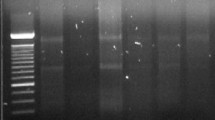Summary
Xenogeneic implants of devitalized cartilage were used as a model system to study the fine structural details of cartilage resorption. The implants were surrounded by a cellular infiltrate consisting of macrophages, fibroblasts, lymphocytes, and eosinophils. Throughout the observation period (2–12 weeks), macrophages formed a palisade-like layer directly opposed to the surface of the implant. The total size of the infiltrate decreased with time. In the acute phase (2 weeks), lymphocytes and eosinophils were abundant but thereafter decreased in number. Consequently, there was a marked predominance of macrophages and fibroblasts in the chronic phase (4–12 weeks). Large multinucleated cells, believed to represent polykaryons formed by fusion of macrophages, were also observed. These findings indicate that inflammatory cells are capable of resorbing cartilage without the participation of living chondrocytes. Apparently, macrophages have direct responsibility for the resorptive process. The role of the other cell types is less clear. In the early period after implantation, they may interact with the cartilage and release factors that stimulate and direct the function of the macrophages.
Fine structurally, the macrophages were characterized by a large Golgi complex and numerous coated vesicles. In contrast, phagosomes and lysosomes were few. The coated vesicles were located in the Golgi area, where they appeared to form by budding from dilated rims of stacked cisternae, and in the peripheral parts of the cells, opposing the implant. It is suggested that the coated vesicles transport degradative enzymes from the Golgi complex to the plasma membrane for release extracellularly. This conforms to the idea that cartilage resorption is a lytic rather than a phagocytic process. Out findings agree with and partly extend earlier observations on cartilage resorption in connection with inflammatory joint diseases and tumor invasion.
Similar content being viewed by others
References
Ali SY, Evans L (1973) Enzymic degradation of cartilage in osteoarthritis. Fed Proc 32:1494–1498
Bainton DF (1981) The discovery of lysosomes. J Cell Biol 91:66s-76s
Dingle JT (1981) Catabolin - a cartilage catabolic factor from synovium. Clin Orthop 156:219–231
Farquhar MG, Palade GE (1981) The Golgi apparatus - (1954–1981) - from artifact to center stage. J Cell Biol 91:77s-103s
Goldstein JL, Anderson RGW, Brown MS (1979) Coated pits, coated vesicles, and receptor-mediated endocytosis. Nature 279:679–685
Kobayashi I, Ziff M (1975) Electron microscopic studies of the cartilage-pannus junction in rheumatoid arthritis. Arthritis Rheum 18:475–483
Kuettner KE, Pauli BU (1981) Resistance of cartilage to invasion. In: Weiss L, Gilbert HA (eds) Bone metastasis. GK Hall Medical Publ., Boston, p 131
Page RC, Davies P, Allison AC (1978) The macrophage as a secretory cell. Int Rev Cytol 52:119–157
Pastan IH, Willingham MC (1981) Receptor-mediated endocytosis of hormones in cultured cells. Annu Rev Physiol 43:239–250
Pawlowski A, Malejczyk J, Ksiazek T, Moskalewski S (1982) Resorption of calcified and decalcified costal cartilage. A study of iso- and alloimplantation in rats. Chir Plastica 7:59–66
Scherft JP (1972) The lamina limitans of the organic matrix of calcified cartilage and bone. J Ultrastruct Res 38:318–331
Schenk RK, Wiener J, Spiro D (1968) Fine structural aspects of vascular invasion of the tibial epiphyseal plate of growing rats. Acta Anat 69:1–17
Thyberg J (1977) Electron microscopy of cartilage proteoglycans. Histochem J 9:259–266
Vaes G, Huybrechts-Godin G, Peeters-Joris C, Laub R (981) Cell cooperation in collagen and proteoglycan degradation. In: Dingle JT, Gordon S (eds) Cellular interactions. Elsevier/North-Holland Biomedical Press, Amsterdam, p 241
Vischer TL (1982) The possible role of cellular interactions in the pathogenesis of the rheumatoid joint lesions. Adv Inflammation Res 3:55–63
Author information
Authors and Affiliations
Additional information
On leave from the Department of Histology and Embryology, Institute of Biostructure, Medical School, Warsaw, Poland
Rights and permissions
About this article
Cite this article
Ksiazek, T., Thyberg, J. Electron microscopic studies on resorption of xenogeneic cartilage implants. Vichows Archiv A Pathol Anat 399, 79–88 (1982). https://doi.org/10.1007/BF00666220
Accepted:
Issue Date:
DOI: https://doi.org/10.1007/BF00666220




